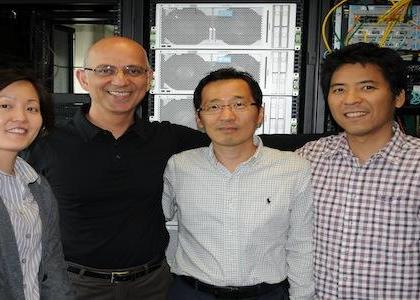
Abdominal aortic aneurysm (AAA) is a focal enlargement, and its rupture is the leading cause of death in large elderly populations. Dr. Baek’s research through a more in-depth understanding of the pathophysiology of the disease and computational biomechanics, shows that a patient’s individual risk assessment reduces AAA-related mortality. Parallel computers at MSU’s High Performance Computer Center (HPCC) allow his research teams to predict vascular adaptation for individual patents where innovative statistical and computational methods will develop greater prediction abilities using conventional computers. Incorporation of patient-specific geometries in computational biomechanical analysis promises that the computational biomechanics becomes an essential tool for AAA risk assessment. In the first project, Drs. Baek and Choi (Growth and remodeling model of abdominal aortic aneurysm: toward clinical applications - NIH R01) in collaboration with Dr. Whal Lee at Seoul National University Hospital studied CT images of small AAAs obtained from longitudinal studies and, using a growth and remodeling (G&R) model of AAAs developed from their group, found that the stress distribution of AAAs can be altered by interacting with spine vertebrae during the enlargement. The project exploited this unique data in order to understand biomechanically why the observed changes in the morphology of AAAs occur, identified specific morphological features that estimated the stress distribution better, and developed a computational framework to better predict rupture risk for small AAAs based on medical images and computational analyses over a small number of longitudinal studies.
The uniqueness of this research stems from their novel G&R model and the unique set of longitudinal patient data that is essential for building and validating such models. The proposed research significantly increased our understanding of biomechanics of AAAs during their progression and provided a necessary step toward the clinical application of vascular G&R models for AAA risk assessment and treatment.
Dr. Choi said that the “Patient-specific calibrating G&R computational model according to CT images taken for a patient could be very challenging and will be computationally expensive. However, I am very excited that we are given this great opportunity to work together in an interdisciplinary way to solve this important problem with the help from HPCC.”
The second collaborative project (NIH R21, Baek, Jaberi, Lim, Lee ) will investigate how the aortic wall biomechanics are associated with aneurysm development, thrombus, and hemodynamics. The study presented in this proposal is a joint collaborative effort between the Departments of Mechanical Engineering and Statistics and Probability at Michigan State University and the Department of Radiology at Seoul National University Hospital. Abnormal wall shear stress is considered to be a potentially important factor in aneurysm expansion and rupture risk. Most AAAs, however, develop intraluminal thrombus (ILT) layers during the progression. The role of ILT on AAA expansion is controversial and the presence of ILT increases the complexity in predicting the effect of wall shear stress on AAA expansion. Recent studies also suggest that hemodynamics in the AAA plays a critical role in thrombus formation and its growth. Previous studies, however, used patient-specific models taken from only one time point and have mostly focused on studying relationships between two factors (e.g., wall shear stress vs. AAA expansion, the presence of ILT vs. AAA expansion), which haven’t been successful investigated in fully elucidating relationships between multiple factors. Therefore, the main goal of this project is to systemically study these variables, to examine multiple hypotheses on their relationships, and to possibly develop correlations among them by using longitudinal data from AAA patients. Our teams will use these longitudinal patient data for developing the proposed numerical simulations and testing of hypotheses on AAA expansion and thrombus formation using multivariate statistical analysis. In hemodynamic simulations, we will use the Lagrangian particle method to trace the history of shear stress of platelets and to assess the dynamical effects of high shear for platelet activation at the proximal side of the geometrically complex AAA. The proposed research would help ultimately to determine growth rules for developing better computational models of AAAs, which will become an essential tool in clinical management and surgical treatment of the disease. Dr. Jaberi believes “that the unique clinical data and the study of the effect of hemodynamic factors on AAA expansion and ILT formulation via well established computational fluid dynamics (CFD) and statistical methods will have a high impact on understanding, modeling, and ultimately preventing AAAs.”
Dr. Baek has published articles in numerous scientific journals. He won the National Science Foundation (NSF) CAREER Award as well as NSF and NIH grants.
Funding:
Baek NSF CAREER: Integration of prior knowledge and patient-specific observations in vascular growth and remodeling models
Growth and remodeling model of abdominal aortic aneurysm: toward clinical applications - NIH R01 PI (Baek), Dr. Choi (ME)
Quantitative analysis of relationships among hemodynamics, thrombus, and abdominal aortic aneurysm expansion –NIH R21 PI(Baek Seungik-ME), Dr. Jaberi (ME), Dr. Lim (Statistic and Probability),
